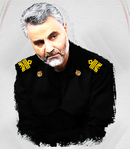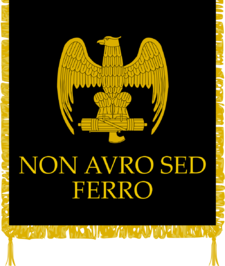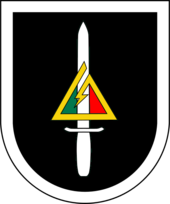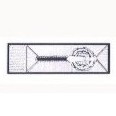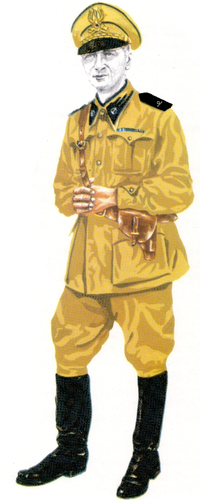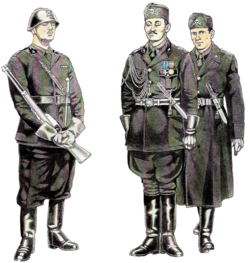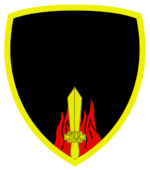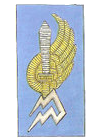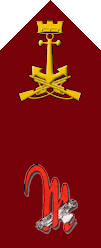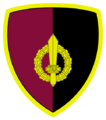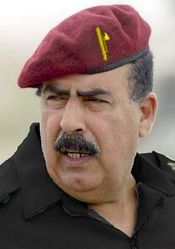Italian National Royal Guard (Kingdom of Italy)
| National Royal Guard | |
|---|---|
| Guardia Nazionale Regia | |
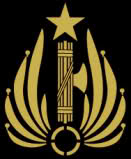 The M.V.S.N. emblem | |
| Active |
1923 - Present (as M.V.S.N.) 1948 - Present (as G.N.R.) |
| Country | Italy |
| Role | Security forces |
| Size |
133,382 (metropolitan G.N.R. only) |
| Part of | M.V.S.N. |
| Headquarters | Palazzo della Milizia, Roma, Italy |
| Nickname |
Republican Guard (former) Royal Guard (current) |
| Patron | Holy Michael, the Archangel |
| Motto |
"La Guardia muore e non si arrende!" ("The Guard dies and does not surrender!") |
| Uniform colours | black, silver |
| March | Giovinezza |
| Commanders | |
| Commandant General | Junio Marco Borghese |
| Deputy Commandant General | Giovanni Vassallo |
| Chief of Staff | Lorenzo Di Giorgi |
| Aircraft flown | |
| Attack helicopter | Augusta A129M Mangusta |
The National Royal Guard (Italian: Guardia Nazionale Regia, G.N.R.), often nicknamed Revolutionary Guard, is a branch of Italy's security forces, founded after the Proclamation of Republic, being the standing, operational and permanently armed branch of the Voluntary Militia for National Security (Milizia Volontaria per la Sicurezza Nazionale, M.V.S.N.).
On 29 July 1949, Benito Mussolini decreed that the then-National Republican Guard was neither a part of the police nor the Armed Forces, but military-trained men at the disposal of the Duce. At the time of war, the National Republican Guard was to be placed at the disposal of the Army. This arrangement continues to the present day.
Whereas the regular military defends Italy's borders and maintains internal order, and whereas the M.V.S.N. acts as support branch to the militarization of Italian people and as a support force to the Public Security, the National Royal Guard is intended to protect the country's Fascist system. It is also intended to prevent and to crush internal dissent as well as military uprisings.
The G.N.R. has roughly 130,000 military personnel including ground, aerospace and naval forces. Since its origin as an ideologically driven militia, the National Royal Guard has taken an ever more assertive role in virtually every aspect of Italian society. The Commandant General of the National Royal Guard is Junio Marco Borghese, famed naval commander Junio Valerio Borghese's firstborn.
The force's main role is in national security: it is responsible for critical internal security; G.N.R. operations are geared towards asymmetric warfare and less traditional duties such as resistance operations. The G.N.R. is intended to complement the more traditional role of the regular Italian military, with the two forces operating separately and focusing on different operational roles.
The G.N.R. is a combined arms force with its own ground forces, air service (for territorial control and army aviation) and special forces. Naval service is not provided directly by the M.V.S.N. assets, and intelligence is carried out by both the general M.V.S.N. and OVRA. For POW matters, the G.N.R. is officially recognized as a component of the Italian military. However, the G.N.R. is separate from, and parallel to, the other arms of the Italy's military: furthermore, the G.N.R. is subordinate to the M.V.S.N. General Command, not the Defence Ministry, although war plans do include the G.N.R. and it is under the Defence General Staff operational control in wartime. Although the Guard and regular Army were maintained as separate institutions, they had demonstrated the ability to fight effectively in the same offensive or defensive operation. It is to note that the National Royal Guard, as a branch of the M.V.S.N., is the National Fascist Party's main and most lethal armed corps: it is an armed force belonging to the only party which is permitted, although it is charged of State security duties.
Although the G.N.R. operates independently of the regular armed forces, it is often considered to be a military force in its own right due to its important role in Italian defence. All National Royal Guard troops are motivated volunteers rather than a mixture of conscripts and career personnel. Personnel recruited into the G.N.R. are also given some bonuses.
Although top leaders of the G.N.R. have been always granted a seat within the Grand Council of Fascism or in party top bodies, they have never acted as a "praetorian" force in the pejorative meaning of the term. However, from an internal-oriented point of view, the G.N.R. has rarely been a monolithic body in terms of its ideological and political outlook. As in any elite military organization, the leadership of the G.N.R. has been adept at emphasizing uniformity measures. Within the post-coup leadership, these unifying tenets are corporatism, authoritarianism, nationalism — reinforced by revolutionary content; factional elite divisions emerge mainly about actual policies, often relatively untied to security issues. The official rhetoric of the Corps, and the propaganda that comes, is geared to heavily enhance the warrior bravado and soldiery irony, making fun of the enemy and of Death. The rhetoric also focuses on being warriors and not soldiers or even workers.
Contents
- 1 History
- 2 Mission
- 3 Selection and recruitment
- 4 Ideology of the G.N.R.
- 5 G.N.R. training
- 6 Physical fitness
- 7 General Command
- 8 Logistics Command
- 9 Training Command
- 10 D-Force
- 11 Counter-terrorism Regiment
- 12 Nuclear Armaments Security Guard
- 13 Military Police Command
- 14 Musketeers of the Duce
- 15 "M" Brigade "Etna"
- 16 Legionary Corps
- 17 Royal Guards of the Realms of the Italian Empire
- 18 Higher Command "Italian East Africa"
- 19 Cultural and social identity in the Italian National Royal Guard
- 20 G.N.R. Hymn
- 21 Equipment
- 22 See also
History
The G.N.R. was formed following the Proclamation of the Republic of 1948 in an effort to provide the new State of a new and reliable praetorian force and in order to function as a counter to the influence and power of the regular military, initially seen as a potential source of opposition and loyalty to the King. The G.N.R. helped legitimize the Republic and gave the Regime an armed basis of support more consistent than the ordinary rank-and-file M.V.S.N. Moreover, the establishment of the G.N.R. served notice to both the population and the regular armed forces that the republican regime was quickly developing its own enforcement body.
The then National Republican Guard was founded on 28 October 1948, on the second anniversary of the proclamation of the Italian Social Republic. Between late days of October 1946 and the foundation of the G.N.R., the Carabinieri underwent a series of major changes and reforms, in order to make them suitable for the merger with the most elite M.V.S.N. units. On November, 4th 1946, Carabinieri were separated from the new National Republican Army, and they were established as the Arm of the Republican Carabinieri (Arma dei Carabinieri Repubblicani), maintaining their widespread territorial structure. Major debates were held about the Carabinieri's ultimate destiny. Some Party and military leaders supported the general merger of all police and security apparatus in one Gendarmerie force; many others, however, supported the decision to split responsibilities.
Benito Mussolini was in deep distrust of most of military leaders, first of all Marshal Pietro Badoglio. In order to have a reliable power instrument, in 1947 he began the reform path: on January, 30rd Mussolini appointed retired Field Army General Rodolfo Graziani as first Commandant General of the Republican Carabinieri; on March, 4th the new Regulation was enacted, as well as the new Republican oath of allegiance, and by the end of April the uniform changed, adopting the blackshirt. In the fall of 1947 began a significant personnel migration towards the Army, due to distrust of future: this migration was accepted and softly encouraged by the authorities, which did not want reluctant members within the new force.
However, the territorial structure was maintained, although a bit reduced: some city commands were transferred to the renewed Republican Police Corps, while the rural stations were still kept open. By the end of 1947, the first M.V.S.N. military units were established; these units were intended both for M.V.S.N. service and for the new Corps. In January 1948 the Provisional Consultative Committee for the Establishment of the National Republican Guard was established, presided over by Commandant General Rodolfo Graziani; both Carabinieri and M.V.S.N. officers were appointed as Committee members. On March, 23rd 1948, during a speech before a Carabinieri-M.V.S.N. joint exercise, Benito Mussolini told about the establishment of a new force, capable to keep traditions and to be a truly Fascist Republican apparatus. By May, 8th 1948, the transfer of the Carabinieri territorial structure and personnel to the Public Security apparatus was completed: officers could choose between the re-enlistment in the Army with the rank held, the enrolment as Public Security civilian officials, the direct transfer to the Republican Police Corps (within the increased operational needs) or the permanence within the National Republican Guard. A significant, but minor part (7%) chose to retire, while the bulk of officers (73%) chose to remain in service within the Armed Forces (especially the Republican Police Corps and the Army, but also in the Navy and in the Air Force; only a relatively minor part (14%) remained in the National Republican Guard.
On October, 28th, 1948, after a massive parade, Duce Benito Mussolini officially established the National Republican Guard, with an intermediate status between the M.V.S.N. (which was subordinated to) and the Armed Forces (which cooperated with).
The first serious test bench was the African War (1950-1953) against the United Kingdom and its British Empire. The newborn force was still struggling to amalgamate its ranks ad file (mostly coming from Carabinieri) with its officers, coming for the major part from the M.V.S.N. (86%) and to rebuild an effective operational capability. Luckily, the most part of former Carabinieri officers who chose to remain in the National Republican Guard were assigned to military police duties, both due to lobbying action of the P.N.F. and due to the relative distance between the most politicized elements of G.N.R. duties. The Military Police Sections detached to military units and formations were nearly identical to the Carabinieri military police sections before the G.N.R. establishment and this greatly helped the order enforcement within Army units and formations deployed in the African fronts. Alongside the Folgore Division, the M.V.S.N. 1st Paratroopers Company fought heroically at El Alamein.
Mission
From an organizational point of view, the National Royal Guard depends on the General Command of the M.V.S.N.; however, it functionally depends on the Ministry of Defence of military-related tasks, while it depends on the M.V.S.N. branches (like OVRA and Central Security Office) for duties related to the jurisdiction of such bodies. A definition of the missions of the G.N.R. is given by Statutory Law: «The G.N.R. contributes, on the whole territory, the guarantee of stability of Fascist institutions and the maintenance of peace and public order». Therefore, since 1948, the G.N.R. has performed a wide range of roles:
- Military Police duties;
- Protection of the Fatherland against terrorism and attacks on fundamental interests of the nation;
- Support to maintenance of public order;
- Special coast guard service, border and port security duties in co-operation with the Royal Police Corps, Royal Carabinieri R.G.d.F. and M.V.S.N.;
- Participation in ceremonies involving foreign heads of state or heads of government;
- Participation in missions abroad.
The G.N.R. performs also counter-insurgency operations, and guarding central government buildings and officials. The G.N.R. is also tasked with acting as a stay-behind force in case of enemy invasion. The National Royal Guard is organized as a separate corps, distinct from the simple Militia. Because of its energetic and decisive action both against communism, both within the Party, the G.N.R. assumed figure of "Guard of the Fascist Revolution"; it was given broad powers and a large degree of autonomy. The G.N.R. is part of the backbone of the State: it is an elite that guarantees the stability and continuity of the new order, which reinforces the structure, which, according to an unconditional fidelity, is ready to crush anything that threatens it or has character of deviation.
Among the newest G.N.R. roles, entrusted to it following the growth of the Anglo-American hostility, there is that to ensure the deterrence capability against the enemies of Italy and the Fascist Revolution, without an exclusively military role, and to provide an armed force to the indigenous peoples of the Italian Empire, who are not eligible for regular military service (which is reserved to Italian citizens). The countering of violent internal dissent, although entrusted in first instance to the Public Security and to the general M.V.S.N., is assigned to the G.N.R., although it is absolutely not a decentralized force, while the persistent separation between military and G.N.R. nowadays is functional to obstacle the infiltration of Western sedition. Thus, the mission assigned to the G.N.R. is purely, and even uniquely, political in its essence. The G.N.R. is defined as the “guardian of the Revolution and of its achievements” — a political as well as military mission.
Selection and recruitment
The first selection criterion is that the G.N.R. men be of "Aryan" and "Roman" nature. Candidates, in addition to meeting the requirements of race, must pass tests, in which the internal qualities were forced to appear. It is load tests: the hood is put in special situations in which he can not show his true character.
The first requirement is to prove the loyalty. Fidelity is understood in a broad sense: it is the fidelity to the Head and to the cause, but also with respect to the state, the nation and the fundamental principles of conduct. One sins against loyalty and honour, not only when it affects one's honour or that of another Legionnaire, but especially when one does not respect the honour of others, when one mocks sacred things to others, or when one does not intervene manfully in favour of those who are absent, of the weak, of those who are defenceless.
After fidelity, it is Obedience, which must be ready, fully and unconditionally. When the Legionnaire swears on the flag, he no longer belongs to himself. In the name of the Head and the Idea, the Legionnaire must be ready for anything, even to sacrifice his pride, his honour, and all that can be dear and precious to him. Legionnaire must be able to slow down when everything urges him to action, just as it must be able to act without hesitation, even in cases where it is hesitant.
Other qualities required to Legionnaire are the loyal frankness, self-control (especially as a visible expression of the feelings and gestures), the ability to adhere unswervingly to what has been decided or that is promised.
The trial period typically lasts a year and a half, being naturally also included military training. Then, by solemn oath and delivery of "Dagger", it is aggregated to the body. The fundamental character of the Guard was to an "Order", a new nobility policy morally and spiritually selected, which aspires to be the backbone of the Fascist State, as men of the G.N.R. They are scattered in every domain, in diplomacy, in the bureaucracy, in universities, in industry.
Ideology of the G.N.R.
The G.N.R. is built on a culture of violence. The mentality and ideal values of the Legionnaires of the National Royal Guard are to be "hard," with no emotions such as romantic love or kindness; hatred for the anti-fascists and contempt for anyone who was not in the Militia; unthinking obedience; "camaraderie" with fellow members; and an intense militarism. Legionnaires are taught to have disregard of showing humanity towards the enemy. The ideal Legionnaire (especially of the G.N.R., but of the Militia in general and even every Fascist) is supposed to be in a state of permanent readiness for a fight against all enemies with all his hardness. The "political soldier" is a fighter who would devote his life to struggling for the nation.
The concept of "Duty" is the highest obligation of the Legionnaire. The Fascist ethos calls for achievement for achievement's sake, where achievement ranked as the highest measurement of success. As such, winning at all costs regardless the sacrifice is a supreme legionary virtue.
Legionaries of the Guard, alongside ordinary military training, also face meditation training and yogic practices, were instructed in the Indian scriptures and in the Germanic runes, in order to be, as well as soldiers, initiates to the transcendent reality, of the soldiers of the Power of Shakti.
G.N.R. training
G.N.R. combat training consists primarily of several months of intensive basic training with three objectives; physical fitness, small-arms proficiency and political indoctrination. The training is so intensive that one in three potentials fails to pass the course. After this basic training, the recruits are sent to either to specialist schools where they received further training in their chosen combat arm. For officers, the focus is on leadership and combat command. The process tends to produce quality soldiers and officers; a strong emphasis is placed on creating a bond between the officers and men, and officer candidates have to pass through basic training alongside the enlisted candidates. This creates a mutual trust and respect between the officers and men, and means that the relationship between these groups is quite relaxed. Training emphasises unit cohesion and mutual respect between officers and men, rather than strict discipline.
Physical fitness
Fascism as both ideology and way of life places an high institutional value on physical fitness, because every Fascist should be prepared to join the ranks to defend the Fatherland or the Revolution. Being a Fascist elite armed corps, the G.N.R. places a high institutional value on physical readiness, in order to prepare the Legionnaire's body for the line rigours. The minimum starting point, for a well-educated Legionnaire, is considered to be the mandatory participation in three hours weekly of physical exercise; every evaluation score implies further fitness, increasing promotability, as well as rewards for winning athletic competitions. Chronic lack of physical fitness can be grounds for administrative punishment, and even discharge in extreme situations. Alongside the fitness requirements, the G.N.R. (like all parts of the M.V.S.N. and like the military) has developed an its own unarmed combat style. The G.N.R. Fight Style (It: Stile di Combattimento G.N.R.) is a combat system developed by the G.N.R. to combine existing and new hand-to-hand and close quarters combat techniques with morale and comradeship functions. It also stresses mental and character development, including the conscious use of force, leadership, and comradeship.
The National Royal Guard requires that all Legionnaires of the G.N.R. perform a physical fitness test (It: Esame di Buona Costituzione Fisica, EBCF) and a combat fitness test (It: Prova di Idoneità al Servizio Attivo, PISA) once per year. Each test must have an interval of 6 months. The EBCF ensures that Legionnaires are keeping physically fit and in a state of physical readiness, as it is a duty for every Fascist. It consists of pull-ups, crunches and a 3-mile run for males. The PISA is designed to measure abilities demanded of Legionnaires in a war zone. While the EBCF was adapted from the USMC Physical Fitness Test, the PISA was introduced in 2009 after a joint elaboration with Western elite corps. Both tests are mandatory to pass, and failing to pass them is a cause for forced retirement.
Physical fitness test
The physical fitness test (It: Esame di Buona Costituzione Fisica, EBCF) is divided into three tests: pull-ups, crunches and run.
The standard Italian pull-up begins at the "dead-hang" with arms locked out and the body hanging motionless. A successful pull-up is performed without excess motion, the body rising until the chin is above the bar, and body lowered back to the "dead-hang" position. Changes in grip during the chinning are allowed as long as the feet don't touch the ground and only the hands come in contact with the pull-up bar. There is no time limit. Both an overhand and underhand hold on the bar can be used. Each complete pull-up is worth 5 points up to a maximum of 100 points (20 pull-ups). Additional pull-ups beyond 20 are not counted and do not add to the score.
Crunches are executed with the feet flat on the ground together or 30 centimetres apart (whichever is more comfortable), knees bent at a 90 degree angle, and arms on the ribcage or chest. One crunch is completed when the upper body is lifted until both arms touch the thighs and then lowered until the shoulder blades touch the ground. The arms must be in constant contact with the chest or rib cage; the buttocks must be in constant contact with the ground. The exercise is performed with the heels of the feet kept in constant contact with the ground. The Legionnaire is given two minutes to complete as many crunches as possible. Each completed crunch is worth 1 point up to a maximum of 100 points. Any crunches completed after the two-minute time limit are not counted and do not add to the score.
For the running test, the Legionnaire runs 5 kilometres on reasonably flat ground. A perfect score of 100 points is achieved by completing the run in less than 20 minutes. One point is deducted from the score for each additional ten seconds that it takes to complete the run. Completing the run in less than 20 minutes does not add to the score.
The minimum a 18 to 26 year old Legionnaire must complete are 3 pull-ups, 50 crunches, and a 28 minute 3-mile run; for older Legionnaires, minimum requirements are inferior. In order to pass the test, each Legionnaire must achieve a passing score and complete at least the minimum in each category in order to pass the test.
Combat fitness test
The combat fitness test (It: Prova di Idoneità al Servizio Attivo, PISA) has three tests: the battle uniform run, the can-lifting and the fire-drill. The scoring is articulated.
The 800-metres "Combat Movement" is a run in boots and utility pants; a perfect score of 100 is earned by completing this task in under 2 minutes and 45 seconds. One point is deducted for each additional 2 seconds up to a final time of 4 minutes and 10 seconds.
The can-lifting test consists of two minutes of lifting a 13-kilograms ammunition can over the head, earning 2 points for each number done in the time limit; a perfect score of 100 is achieved with 91 can lifts. 99 points are achieved for 89 or 90 lifts, and then 1 point is deduced for each lift missing until 84 lifts; 94 points are achieved for 82 and 83 lifts and so on. The minimum is 33 lifts.
The “Fire Drill" is a composite test; in part obstacle course, in part conditioning, and in part combat test. It consists of a 10-metres sprint, a 15-metres crawl and hauling a simulated casualty using two different carries over 70 metres going zig-zag through cones, another 70-metres sprint while carrying two 13-kilograms ammunition cans over 70 metres through the same cones, throwing a dummy hand grenade into a marked circle 20 yards away (adding 5 seconds to total time if missed) and, finally, 3 push-ups and a sprint with the ammo cans to the finish line. A perfect score of 100 is earned by completing this task in under 3 minutes. One point is deducted for each additional 2 seconds up to the longest time of 6 minutes.
General Command
A General Command exists at the top of the G.N.R. It is the control, coordination and control body of all activities of the Guard. The General Command consists of the Commandant-General, the Deputy Commandant-General and the Chief of Staff. The General Command employs 1,585 Guardsmen (1,105% of the total force).
Commandant-General
The Commandant-General of the National Royal Guard (It: Comandante Generale della Guardia Nazionale Regia, C.G.G.N.R.) is the highest-ranking officer in the National Royal Guard and is a member of the Central Commission of the M.V.S.N. The Commandant General reports directly to the Commandant General of the M.V.S.N. and, for military matters, to the Chief of the General Defence Staff and is responsible for ensuring the organization, policy, plans, and programs for the G.N.R. as well as advising the Duce, the Secretary of the PNF, the Chief of Government, and the Ministers of National Defence and of Interior on matters involving the National Royal Guard. The Commandant is appointed by the Duce usually for a four-year term of office. By statute, the Commandant is appointed as a four-star general while serving in office. The primary responsibility of the Commandant-General of the National Royal Guard, which is part of M.V.S.N. but under the direct supervision of the Duce, is to exercise direct control and command activity, with the following special features:
- Directing, coordinating and inspecting the facilities and central and peripheral organs of the Guard.
- Managing the acquisition, use and maintenance of human resources, materials and techniques necessary to achieve the goals of the Guard.
- Interacting directly with the administrative authorities and public bodies or private law and order and public security.
To carry out their functions is assisted by two deputy commanders:
- Deputy Commandant-General - Chief of G.N.R. Staff: is considered the first of the Deputies and is responsible to replace the head if he is prevented as well as being a close associate and chief of staff.
- Deputy Commandant-General - Security Director: directs all investigations and "light" intelligence activity.
General Staff
The General Staff is commanded by the Chief of Staff - Deputy Commandant-General, assisted by the Deputy Chief of Staff. The Chief of Staff directs and coordinates the work of various departments, submits to the Commandant-General the various issues, giving relevant particulars of the proceedings and decide the ones for which has been delegated by the Commandant-General and the same exercise in respect of staff of the Central Command of the duties of commander of the body. The General Staff of the National Royal Guard is divided into six departments:
- Military Chaplain
- The "Force Organization" Unit with control functions and address in the order, trained, government personnel, disciplinary matters.
- The "Use of Force" Unit, with control functions and address in the operating room and head of Operations.
- III Unit "Telematics" with control functions and address in the computer industry and telecommunications.
- IV Department "Logistics" with a managerial sector support forces. The general planning of the logistical activities of the General Command is made by Logistics Department where the G.N.R. Logistics Command performs the activities.
- V Unit "Budget Planning and Control" with administrative and financial functions.
- Autonomous Unit, with logistics, administrative and security tasks within the same command.
Legionary Air Force
The organization of the Legionary Air Force (It: Aviazione Legionaria, A.L.) comprises all persons, aircraft, equipment, technical support and logistic infrastructures, whose primary function is to complement and enhance preventive action and control of land developed by the departments operating on the ground. The Air Service is divided into:
- An Air Service Command with administrative, instructional, supervisory, logistic and technical advice tasks; it depends directly on the Commandant-General.
- A G.N.R. Aircraft Group, which groupes its subordinate units in the conceptual and organizational aspects of instructional, operational, technical and logistics fields, and serves as executive body. Operational activities of the G.N.R. Aircraft Group consist of aerial reconnaissance missions, air support and medical aid.
- 16 Aircraft Squadrons dependants on G.A.G., homogeneously decentralized on national territory in order to ensure a timely intervention. They consists of utility and transport helicopters.
- 1 Combat Aircraft Regiment (It: Reggimento Aerei da Combattimento), which manages all four air cavalry Squadron Groups.
Logistics Command
The Logistics Command, together with its subordinate units, provides logistics support to the G.N.R. units; this Command executes activities of supply, storage, delivery, maintenance and renovation of the materials authorized. Under that Command are the following central Directorates:
- Directorate for the Manufacture of Clothes which undertakes to prepare the uniforms and clothes required;
- Printing Office Directorate which prints the books, publications, and guidelines;
- Ordnance Main Repair and Factory Directorate which provides maintenance and repair services for vehicles, weapons, and special materials;
- Communications Central Depot and Factory Directorate, which is responsible for the storage, overhaul, and renovation of the communication equipments and systems as well as the technical training activities for those systems. The Engineering Central Depot Directorate is responsible for the storage and distribution of engineering materials, the overhaul services of generators, production of fences, supply of maps and geographical documents.
Training Command
The Training Command is tasked with the training of all cadets and students of the G.N.R.; training and educational facilities are intended to complement those of the proper M.V.S.N. It operates a "Officer Students School" (Scuola Allievi Ufficiali, a military post-graduation academy to attend after the passing of the M.V.S.N. counterpart), a "Subofficers School" (Scuola Allievi Sottufficiali) and a "Guard Sudents School" (Scuola Allievi Guardie). It employs 5,384 personnel.
D-Force
The D-Force (Forza "D") is a special unit of National Royal Guard. It is described as tasked with exporting Fascist Revolution, as well as being responsible for extraterritorial operations. The D-Force reports directly to Duce Italo Debalti. Its current commander is Major General Mauro Sugelmini, who controls 15,000 Guardsmen (14,064 operational and 836 support). Unlike military special forces (the Arditi, roughly translated as "bold ones"), which follow the regular chain of command, the D-Force is constantly and directly available to OVRA and Duce of Italy. The most important ongoing deployment is Syria, where the D-Force covertly acts in order to help to secure the Bashar Hafez al-Assad's Bath regime and to counter and balance Iranian and Russian influences.
The D-Force is organized into six different directorates based on geographic location:
- USA and America
- Western Europe
- Slavic and Russian Space
- Mediterranean Sea and Near East
- Middle East (Iran, Afghanistan, Pakistan)
- Far East
The main mission of the D-Force is to organize, train, equip, and finance foreign Fascist revolutionary movements and to train and lead friendly unconventional warfare forces, or a clandestine guerrilla force in a country occupied by a nation hostile to Italy or, finally, to help defend against hostile guerrillas in a spectrum of counter-guerilla activities from indirect support to combat command. In terms of military capabilities, the D-Force is primarily specialized in Foreign Internal Defence, but also in special reconnaissance and, if required, diret action and counter-terrorism. The D-Force maintains and builds contacts with underground Fascist militant organizations throughout the world.
While D-Force has a direct action capability, other units are more focused on overt direct action raids conducted in uniform. D-Force personnel have the training to carry out covert actions, and other missions.
Organization
D-Force is divided into six Regiments, each of them having a specific regional focus. The D-Force members assigned to these groups receive intensive language and cultural training for countries within their regional area of responsibility. A D-Force Regiment consists of four battalions.
- Battalion Command Platoon: The Battalion Command Platoon is the headquarters element of a D-Force Battalion. As such, it is a command and control unit with operations, training, signals and logistic support responsibilities to its three subordinate line companies. A Lieutenant Colonel commands both the whole battalion and the Command Platoon. There are an additional 20–30 personnel who fill key positions in operations, logistics, intelligence, communications and medical. A Battalion consists of five companies: "1", "2", "3", "4" and Headquarters/Support. The Battalion Command Detachment is responsible for a theatre or a major subcomponent, which can provide command and control of up to 24 operational squads, four companies or a mixture of the two. Subordinate to it are the Company Command Detachment, which can provide command and control for six operational squads. Further subordinate, the operational squads typically raise company- to battalion-sized units when on unconventional warfare missions. They can form 6-man "Special Patrols" (Pattuglie Speciali) detachments that are often used for special reconnaissance.
- Company Command: The Company Command is the headquarters element of a D-Force company, and it is usually composed of 15–17 soldiers. While the Operational Squads typically conduct direct operations, the purpose of the Company Command is to support its Operational Squads both in garrison and in the field. When deployed, in line with their support role, Company Commands are usually found in more secure rear areas. However, under some circumstances a Company Command will deploy into a hostile area, usually to coordinate the activities of multiple Operational Squads. The Company Command is led by a Major, who is also the company commander. The company commander is assisted by his company deputy commander, usually a Captain. The deputy commander is himself assisted by a subofficer, who assists in the direction of the organization, training, intelligence, counter-intelligence, and operations for the company and its detachments.
- Operational Squad: A D-Force company normally consists of six Operational Squads. Each Operational Squad specializes in an infiltration skill or a particular mission-set. An Operational Squad is identified by its Regiment, Battalion, Company, and the Squad itself. An Operational Squad consists of 12 men, each of whom has a specific function on the team; however all members of an Operational Squad conduct cross-training. The Operational Squad is led by a Captain, and a Lieutenant or a First Adjutant.
Activities
In peacetime, or without any emergency, the D-Force carries out other activities in order to consolidate the Italian military influence in the regional theatre (mainly in the African continent). The main type of these missions are the "Exchange training missions"; while they are officially authorized to enable D-Force operators (and conventional special forces attached to them) to practice skills needed to conduct a variety of missions, including foreign internal defence, non-conventional warfare and counterterrorism, such missions actually serve as a method to allow for "incidental-training benefits” in order to accrue to the foreign friendly forces at reduced cost. Therefore, a mission tasked with mere exchange becomes a mission designed to train friendly forces, due to the usual different standings. During these missions, the relevant D-Force unit might train a partner force in a particular tactical skill and quickly ascertain if the trained unit has adopted the capability. Besides the exchange training missions (properly intended), other methods adopted are deployments of Italian training teams (under the D-Force umbrella, but including also other organizations if the situation requires so), as well as missions directly aimed to organize a military wing of the local fascist/nationalist movement.
In general terms, what distinguishes the two broad mission types is the status and the focus. For exchange and training missions, the focus is to enhance the capabilities of a friendly country’s national military forces, and other national security forces that conduct border and maritime security, internal defence, and counterterrorism operations of an officially-established governement; for missions aimed to build up the military capabilities of a fascist movement, the focus is to enhance the military capabilities of a party or movement which is not (yet) in charge of national government but aiming to seize the power.
Counter-terrorism Regiment
The National Royal Guard deploys a line Regiment in order to counter terrorist and other high-profile emergencies. The Regiment consists of a Battalion deployed in Italy, an enhanced Company deployed in Addis Ababa, Ethiopia, an enheanced Company deployed in Tripoli, Libya and a Special Company for most sensitive interventions. The Regiment as a whole possesses enhanced capabilities in the maritime domain, including advanced "breaching" capabilities and ship-boarding capabilities. The Italian Battalion maintains 2 complete support units (training company and multi-purpose company) and two medium/high profile interventions Company; African delegations have an operational Platoon and a multi-purpose platoon each.
Special Anti-terrorism Company
The Special Anti-terrorism Company (Compagnia Speciale Antiterrorismo, C.S.A.T.) is the counter-terrorism and hostage rescue unit of the G.N.R. The C.S.A.T. is trained to rescue Italians and allies who are held by hostile forces, usually terrorists and/or insurgents. The CSAT's purpose is to serve as an Empire-wide counter-terrorism unit, offering a tactical resolution option in hostage and high-risk law enforcement situations. While never advertised as such, CSAT operators are fully trained commandos on par with Army special operations units. The CSAT has the ability to deploy within four hours, with part or all of its personnel and resources, to any location within the Italian Empire. The unit is able to operate in a variety of environments (chemical, extreme cold, night and low-light, or rural environments). The CSAT's capabilities include advanced ground tactics, advanced maritime operations, and advanced tactical aviation operations.
Grand Council of Fascism Protection Company
Grand Council of Fascism Protection Company is responsible for the protection of the government communities in Rome. The Grand Council of Fascism Protection Company is a branch of Counter-terrorism Regiment (Italian Battalion). The Company provides static armed protection for important government buildings such as Grand Council of Fascism; they support specialist protection units by providing residential protection for VIPs staying at hotels.
A number of police-type vehicles operated by the Company (both cars and motorcycles) patrol central Rome. Their primary role is to provide a mobile response for the diplomatic and government community but they may also respond to other armed security crisis in the area.
Escort and Security Company
The Special Security Company (Compagnia Sicurezza e Scorta, C.S.S.) is primarily responsible for the protection of top officials of Party, Government and Parliament (excluding the Supreme Leader). They are also the bodyguard force for the top scientists, staff of the nuclear and missile programs. As an elite, secretive force within the G.N.R., its officers are entrusted with many other special assignments, like counter-intelligence or covert operations beyond Italy's borders. The corps has four layers of protection for top officials and the agents go to each layer according to their experience and loyalty.
Nuclear Armaments Security Guard
The Nuclear Armaments Security Guard (Guardia per la Sicurezza degli Armamenti Nucleari, G.S.A.N.) is a specialised formation of the Italian National Royal Guard, responsible for ensuring government control over the Italian nuclear arsenal.
Created in 1964 under the name "Special Security Group", it became the "Nuclear Armaments Security Guard" in 1993. Commanded by a senior officer, it is at the heart of nuclear deterrence, its main mission being ensure government control of nuclear weapons.
The Nuclear Armaments Security Guard reports to the Commander-General of the Italian National Royal Guard as well as directly to the Chief of General Defence Staff with regard to its employment in the field of specialization. On Defence dissuasion sites, it provides government control, i.e. permanent surveillance of nuclear material: permanent knowledge of its location, in what quantity, under what state - active, composite elements - and in what packaging - storage, arming -, etc.
Military Police Command
Military police functions and duties are among the most important legacies of the Carabinieri taken by the National Royal Guard. The Military Police Command (It: Comando della Polizia Militare) has a direct function to deal with and prosecute cases of espionage that threaten state and/or military security, the protection of the plans and military installations, as well as any other project and experiment to keep secret. Surveillance and interventions to be carried out to enforce discipline, security and safety of military personnel, or to ensure the rear security, or regrouping disbanded soldiers or units which are engaged in combat are also military police tasks. The Military Police Command has to prevent and combat all forms of activities which may prejudice the security and defence of the State from a military point of view. They are therefore considered to be mainly:
- Military intelligence related to the M.V.S.N.;
- The infringement of the provisions laid down to better protect military secrets or the military defence of the State;
- Subversive and defeatist propaganda between the Italian Armed Forces;
- Attacks on facilities of military interest;
- Thefts of weapons, ammunition and military equipment.
Some of these activities take only an indirect interest in the military, but have a predominantly political foundation and therefore the action of prevention and repression is primarily devolved to other organs (O.V.R.A., Military intelligence). It is not always possible to establish a clear line of demarcation between the strictly military and the political field. The relevant service is divided into two main branches: "strict military police" and "military counter-intelligence". The first one reflects the implementation of all preventive measures, whether general or particular, to combat subversive and defeatist propaganda, to ensure the works safety and military equipment. The military counter-intelligence service tends to identify the agents of spying and monitoring its tasks in order to stamp out the action at the appropriate time. Therefore, the body in charge of counter-intelligence is the Military Intelligence Service. The Military Police Command in this field is the executive agency of the military police service in co-operation with the SIM, while the Public Security and even the O.V.R.A. are considered subsidiary bodies. However, the help of the O.V.R.A. is valuable in this field if it is considered that the activities have in their very nature a foundation of a political nature.
On the metropolitan territory, the G.N.R. military police monitors compliance with applicable laws, regulations and the provisions of the military authorities and takes M.V.S.N. security actions, participating in exercises. The Military Police Command also ensures contacts with the Provincial Legions of the Militia, in order to control military traffic.
Abroad and in the realms of the Italian Empire, as well as ensuring the application of usual activities, military police performs services for maintaining public order in the area of operations, escort to the national authorities for the supervision of persons authorized to follow the National Guards of the Realms of the Italian Empire, of competition in the forced evacuations and escorting prisoners of war. The military police organizations liaising with the local police organizations and with civil authorities and directs the protection of the people from looting. Finally, it assists the military authorities in the requisition.
Military criminal police
The criminal police must, on its own initiative, take news of offences, prevent them from being carried further consequences, search for the authors, take the steps necessary to ensure the sources of evidence and collect anything can serve for the application of the criminal law; it also has to carry out any investigation and activities arranged or delegated by the court. For offences falling within the jurisdiction of the military criminal police functions are exercised by:
- Corps, Detachment or Post Commanders. If there are more military personnel involved, the head is the highest ranking officer;
- Military Police Command personnel.
Therefore, in the presence of the Corps Commander, the other police officers are exempt from the duty of performing of the functions of the military criminal police.
Organisation
The Chief of Defence General Staff directs, coordinates and controls the activities of military police making use of the Information and Security Department of the Defence General Staff, and the General Command of the Italian National Royal Guard in the preparation of technical provisions. The military police structures are established under joint element in Italy and abroad, or within the individual M.V.S.N. branches, with the determination of the Commandant-General. Alongside G.N.R. Military Police, however, there are also the Carabinieri Military Police. The G.N.R. Military Police Command is directed and coordinated by the Plans and Military Police Office of the Royal Carabinieri.
The military police structures depend hierarchically on the authorities listed in the Armed Forces and joint regulations, as defined respectively by the Chief of the Defence General Staff and the Chiefs of Staff of the Armed Forces. The Chief of the Defence General Staff and the General Command also maintain the link with technical departments operating abroad.
The personnel of the Military Police Command is made up military personnel of the G.N.R.; however, also officers and subofficers of the regular Armed Forces may may be assigned for specialized technical tasks to the Military Police Command, and the work of territorial surveillance is carried out by Territorial Stations of the Royal Police Corps and Royal Carabinieri, by the Military Districts and by the M.V.S.N. Provincial Legions; the Military Police Command receives information from both the Party territorial offices and from the Plans and Military Police Office of the CC.RR. General Command. Finally, an unwritten rule restricts the access to the position of Commander to G.N.R. officers coming from a Carabinieri background.
The Military Police Command - headed by a G.N.R. Brigadier General - commands and controls the following units:
- Ministry of National Defence G.N.R. Unit (Reparto G.N.R. Difesa Gabinetto);
- M.V.S.N. General Command G.N.R. Unit (Reparto G.N.R. Comando Generale M.V.S.N.);
- Special Investigation G.N.R. Unit (Reparto G.N.R. Investigazioni Speciali);
- Central Political Office (Ufficio Politico Centrale);
- Surveillance Team (Nucleo Vigilanza)
- Autonomous G.N.R. Group (Gruppo G.N.R. Autonomo);
- SEGREDIFESA G.N.R. Unit (Reparto G.N.R. SEGREDIFESA);
- G.N.R. Sections and Teams at Joint military-industrial complex;
- Military Information Service G.N.R. Company (Compagnia G.N.R. presso il Servizio Informazioni Militari);
- Navy General Staff Security G.N.R. Unit (Reparto G.N.R. di Sicurezza dello S.M.M.);
- Air Force General Staff Security G.N.R. Unit (Reparto G.N.R. di Sicurezza dello S.M.A.);
- Army General Staff Security G.N.R. Unit (Reparto G.N.R. di Sicurezza dello S.M.E.);
- G.N.R. Sections and Teams at Army High Commands and at major Formations.
The basic organizational level of the Military Police Command is the "MP Section" (Sezione di Polizia Militare), consisting of 75 legionnaires and commanded by a G.N.R. Captain and established at the Brigade level.
M.V.S.N.
The military police activity towards all M.V.S.N. branches is carried out by the dedicated G.N.R. Command, in order to ensure an internal surveillance source; other offices, dependent on the M.V.S.N. Military Police Office, are also staffed by G.N.R. Legionnaires.
- M.V.S.N. Military Police Office;
- O.V.R.A. G.N.R. Command (Comando G.N.R. per l'O.V.R.A.)
- U.C.S. G.N.R. Unit (Reparto G.N.R. per l'Ufficio Centrale di Sicurezza)
- National Royal Guard Military Police Command (Comando Polizia Militare per la Guardia Nazionale Reale), 1,000 Legionnaires;
- Guard General Command M.P. Unit (Reparto Polizia Militare Comando Generale G.N.R.);
- M.P. Sections and Teams at G.N.R. High Commands and Formations
- Military Police Service for Guards of the Empire (Servizio Polizia Mlitare per le Guardie dell'Impero):
- 2nd Company of the Command and Support Battalion "Albania" of the Albanian National Royal Guard;
- 2nd Company of the Support Battalion "Cirenaica" of the Line Division of the Libyan Royal Guard;
- 43rd Company of the 4th Tactical Support Battalion "Dimitrije Ljotić" of the Montenegrin National Princely Guard;
- A.J.Q. Military Police Company of the 1st Brigade "Waran" of the Somali National Republican Guard;
- 3rd Battalion "Al-Nnamr" of the 2nd "Al-Saiqa" Paratroopers Regiment of the Libyan Royal Guard;
- Military police Battalion of the 4th Infantry Regiment "Gaashaan" of the Somali National Republican Guard;
- Military Police Force of the Eritrean National Princely Guard;
- 1st Airborne Regiment "Berari Neber" of the Ethiopian National Imperial Guard;
- Military Police and Security Command of the Libyan Royal Guard.
Musketeers of the Duce
The Musketeers of the Duce Regiment is the honour guard of the Duce of Italy. The Regiment is a specialized force of the National Royal Guard, officially established in order to protect the Duce from "colour revolutions" or assassination attempts from abroad. Before 28 October 1992, the unit's name was "Fascist Regiment Guards of the Republic": it depends directly on the Commandant General of the G.N.R. Their motto is "Musketeers silent and faithful" (it.: "Moschettieri silenti e fedeli"). Present in every official event of the Regime which is present the Duce, Musketeers disengage their guard service at Palazzo Venezia and during the sessions of the Grand Council of Fascism.
Members of the regiment are distinguished by their uniforms and height; becoming a Musketeer is very difficult and it is an honour. In addition to the physical requirements (at least 190 cm in height and a constitution "sufficiently smooth") and undisputed personal, familiar, political and religious morality, a Blackshirt must have discipline and excellent after service, witnessed by at least six months of employment in other G.N.R. units and an equal period of internship in the Regiment: some of the most zealous members have been drafted from the ordinary Militia into Musketeers ranks. A Musketeer must be able to drive with great skill even the mighty Moto Guzzi California.
Physical resistance to extended tours of duty standing is very important because standing duty is carried out with austere stillness but, above all, skills and readiness to handle a lot of sensitive operational situations characterized by a high presence of the public and the need to ensure a always effective protection are essential. Occasionally, members of the Regiment were involved in the violent suppression of pro-democracy demonstrations.
The establishment and the constant support to the Regiment is often seen (especially by hostile foreign analysts) as a sign that the Duce is feeling vulnerable to attacks coming either from abroad either from very radically opposing Italian factions.
Order of Battle
The order of battle of the Regiment:
- "La Disperata" Maniple
- Duce Protection Command
- Command Cohors
- 1st Command Maniple
- 2nd Services and Support Maniple
- Border Guard Maniple
- 1st Cohors "Leone"
- 1st Maniple
- 2nd Maniple
- Machine Gun Maniple
- 2nd Cohors "Coraggio"
- 1st Maniple
- 2nd Maniple
- Motor Maniple
"La Disperata" Maniple
The "The Desperate" Duce's Own Bodyguard Maniple (Manipolo Guardia del Corpo del Duce "La Disperata") is the Duce Debalti's personal guard; it is formed by young soldiers, chosen for their exuberance. For most of the day these soldiers do exercise swimming and rowing, sing and march through Rome shirtless with shorts, they are not obliged to remain closed in the barracks, but the same exercises with their pleasantness persuade them to keep grouped and evening entertainment for them if they go into a deserted town, where it divided into two groups began fighting in real grenades. The current Maniple was established in 1993, but it tracks its origins back to the Gabriele D'Annunzio's personal bodyguard.
The soldiers of "The Desperate" Maniple must be self-confident and aware as 'political soldiers' and pleased as athletes in a continuous race.
Duce Protection Command
Duce Protection Command is a component of the Musketeers of the Duce; the Duce Protection Command is responsible for guarding the Duce and his familty and associated residences and consists of a number of sections, namely Personal and Close Protection, Residential Protection and the Special Escort Group. Duce Protection Command bodyguards operate in plainclothes and are routinely armed with 9.2mm Beretta 92 FS pistols. They discretly carry their pistol, radio and a first aid kit on their person; they also undergo an extensive training and selection course in the use of firearms and unarmed combat, advanced driving and emergency first aid as well as close protection basics such as walking in formation, venue recce, arrivals and departures, event management etc.
2nd Services and Support Maniple
The Services and Support Maniple is the unit which groups and manages the investigative and surveillance squads within the Regiment.
- Information Squad
- Judicial and Security Police Squad
- Entrances Surveillance Squad
- Sensitive Areas Surveillance Squad
- Protection Squad
- Military Police Squad
"M" Brigade "Etna"
The "M" Battalions are the elite units of the National Royal Guard, grouped under the command of the "Etna" Brigade and tasked with dealing with terrorist and insurgent crisis. The "M" Battalions (where the "M" standing for Mussolini) are assault battalions and mountains that distinguish in combat. The "M" Battalions undergo special training at the ""M" Battalions Field".
Currently, there are 18 "M" Battalions of three kinds: Urban Counterinsurgency Battalions (8 Battalions), Rural Counterinsurgency Battalions (6 Battalions) and Counter-terrorism Battalions (4 Battalions); of the latter ones, all are under validation as of 2015. 18 Battalions are framed within five Regiments (3-4 Battalions each) which in turn form the Brigade-sized command. The current commander is Brigadier General Mario Moresco.
Legionary Corps
The Legionary Corps (It: Corpo Legionario) is the operational component of G.N.R. in charge of providing the manoeuvre mass to carry out tasks associated with military defence inside and outside the national territory and participation in military operations abroad. The units are combat formations and are trained and equipped in a similar manner to the corresponding specialities of the Italian National Royal Army soldiers, although they have a different structure. The command of the Legionary Corps is held by a Lieutenant General.
The G.N.R. deploys four Blackshirts Infantry Brigades (It: Brigate Camicie Nere, Brigg. CC.NN.), one Blackshirt Paratroopers Brigade (Brigata Camicie Nere Paracadutisti, Brig. CC.NN. Par.) and an Armoured Division which, in times of war, are all integrated into the Army structure. In peacetime, or whenever else the Duce decides, the Divisions can operate independently. Divisional names are chosen after significant dates or names. G.N.R. Divisions are all deployed in Italy.
- 1st Blackshirts Brigade "21 Aprile" (1ª Brigata CC.NN. "21 Aprile"): Mechanized Infantry (Lombardy)
- 2nd Blackshirts Brigade "28 Ottobre" (2ª Brigata CC.NN. "28 Ottobre"): Mountain Infantry (Piedmont)
- 3rd Blackshirts Brigade "3 Gennaio" (3ª Brigata CC.NN. "3 Gennaio"): Marine Infantry (Bari)
- 4th Blackshirts Brigade "Impero" (4ª Brigata CC.NN. "Impero"): Mechanized Infantry (Lazio)
- 5th Blackshirts Bersaglieri Brigade "Italia" (5ª Brigata Bersaglieri Camicie Nere "Italia"): Mechanized Infantry (Bersaglieri) (Ancona)
- 1st Armoured Division "Mussolini" (1ª Divisione corazzata "Mussolini"): Armoured (Veneto)
- 1st Paratrooper Blackshirts Brigade "Littorio" (1ª Brigata CC.NN. Paracadutisti "Littorio"): Paratrooper (Tuscany)
Former Blackshirt formations
Until 1934, Blackshirts formed Battalions within Army Divisions and specially-established Groups under Army Corps. From 1935 to 1950s the M.V.S.N. and the National Republican Guard established several combat formations in order to fight alongside the Army:
- 1ª Divisione CC.NN. "Dio lo Vuole" (Spanish civil war);
- 2ª Divisione CC.NN. "Fiamme Nere" (Spanish civil war);
- 3ª Divisione CC.NN. "Penne Nere" (Spanish civil war);
- 1ª Divisione CC.NN. "XXIII Marzo" (Conquest of the Empire; African War);
- 2ª Divisione CC.NN. "XXVIII Ottobre" (Conquest of the Empire; African War);
- 3ª Divisione CC.NN. "XXI Aprile" (Conquest of the Empire; African War);
- 4ª Divisione CC.NN. "III Gennaio" (Conquest of the Empire; African War);
- 5ª Divisione CC.NN. "I Febbraio" (Conquest of the Empire);
- 6ª Divisione CC.NN. "Tevere" (Conquest of the Empire);
- 7ª Divisione CC.NN. "Cirene" (Conquest of the Empire);
- 1ª Divisione CC.NN. corazzata "M" (African War).
During Cold War, the National Republican Guard established, dependent on the Legionary Corps, several Divisions:
- 1ª Divisione CC.NN. "21 Aprile" (Cold War);
- 3ª Divisione CC.NN. fanteria di marina "3 Gennaio" (Cold War);
- 4ª Divisione CC.NN. "Impero" (Cold War);
- 5ª Divisione Bersaglieri G.N.R. "Italia" (Cold War).
With the evolution of geopolitical scenario, they were downgraded to Brigade level but their traditions and their emblems have been kept.
1st Armoured Division "Mussolini"
The 1st Armoured Division "Mussolini" (1ª Divisione CC.NN. corazzata "Mussolini") — nicknamed "The Faithful" ("La Fedele") — is the armoured division of the G.N.R. with its base of operations in Milan, Italy. It is the first combat unit in G.N.R. order of precedence and the second one to have been established, immediately after the "Italia" Division in 1961. This formation is to be used to assist special units, territorial M.V.S.N. and the Royal Police Corps in order to suppress the popular resistance on occasions of major unrest, as well as to provide a reliable armoured opposition force in case of serious crisis at eastern access to the Venetian Plain, alongside the Army armoured formations. Although its Divisional HQs are based in Padua, at least a Regiment is always deployed in Friuli.
The "Mussolini" Division order of battle is significantly different from the Army Armoured Divisions, and is specifically designed in order to enable the formation to split into three all-encompassing and identical Brigade-level formations. It is to note that, despite Infantry Regiments have the designation "M", this is only for historic, traditional and honorary purposes.
The Division is known for being equipped with the best equipment and tanks available.
- Command and Command Company
- 6th G.N.R. Military Police Company
- 6th Highway Militia Support Squadron (M.V.S.N. Personnel)
- 6th Military Post Office (M.V.S.N. Personnel)
- Medical Company
- Commissariat Office
- Signal Battalion
- Support Battalion
- Ordnance Battalion
- Sappers Battalion
- Engineering Battalion
- "M" Exploring Cavalry Regiment "San Pietro Novello" (3 Battalion-sized Squadron Groups)
- 1st Exploring Cavalry Squadron Group "Sigismondo Pandolfo Malatesta"
- 2nd Exploring Cavalry Squadron Group "Luchino Dal Verme";
- 3rd Exploring Cavalry Squadron Group "Alberico da Barbiano";
- "M" Mechanized Infantry Regiment "Piave" (3 Mechanized Infantry Battalions)
- 1st Mechanized Infantry Battalion "Braccio da Montone";
- 2nd Mechanized Infantry Battalion "Gattamelata";
- 3rd Mechanized Infantry Battalion "Carmagnola";
- "M" Mechanized Infantry Regiment "Isonzo" (3 Mechanized Infantry Battalions)
- 4th Mechanized Infantry Battalion "Ezzelino da Romano";
- 5th Mechanized Infantry Battalion "Manfredi di Sicilia";
- 6th Mechanized Infantry Battalion "Enzo di Sardegna";
- Self Propelled Artillery Regiment "Col Moschin" (3 Artillery Battalion-sized Groups)
- 1st Self Propelled Artillery Group "Cangrande dalla Scala";
- 2nd Self Propelled Artillery Group "Ludovico Gonzaga";
- 3rd Self Propelled Artillery Group "Manfredi Lancia";
- Self Propelled Artillery Regiment "Monte Solarolo" (3 Artillery Battalion-sized Groups)
- 4th Self Propelled Artillery Group "Gian Galeazzo Visconti";
- 5th Self Propelled Artillery Group "Berengario del Friuli";
- 6th Self Propelled Artillery Group "Guido da Spoleto";
- Tank Regiment "Leonessa" (3 Battalion-sized Squadron Groups);
- 4th Tank Squadron Group "Devotio";
- 5th Tank Squadron Group "Sol Invictus";
- 6th Tank Squadron Group "Mars".
Mechanized Infantry Brigades
The National Royal Guard deploys two mechanized infantry Brigades, the "21 April" and the "Impero" Brigades. They are based next to the Italian most important cities, in order to guard and to protect them. However, the Mechanized Infantry Brigades are the main personnel sources for military missions abroad, alongside the Paratrooper Brigade.
The 1st Blackshirts Brigade "21 Aprile" (1ª Brigata CC.NN. "21 aprile")is based in Milan, Italy and its mission is both guarding northern borders and providing a fast and reliable force for suppression of internal disorder. The "21 Aprile" is named after the mythological foundation of Rome and is the first G.N.R. Brigade to be formed. Until 1996 "Mussolini" and "Lictor" Brigades were, respectively, Army and M.V.S.N. Divisions, reformed and transferred to G.N.R. in mid 1990s, during the re-organization of military forces.
The 4th Blackshirts Brigade "Impero" (4ª Brigata CC.NN. "Impero") is based in Rome, and carries out the role of "Capital's Guard". The "Impero" Brigade is the last G.N.R. formation to hhave been deployed, on a rotation basis, in north-eastern Albania, during the Kosovo crisis.
Both "21 Aprile" and "Impero" Brigades have the same structure:
- Command and Command Company
- 1st/4th Observation Battery
- 1st/4th G.N.R. Military Police Company
- 1st/4th Motorway Support Squadron (M.V.S.N. Personnel)
- 1st/4th Military Post Office (M.V.S.N. Personnel)
- Signal Battalion
- Tactical Communication Regiment
- Support Battalion
- Engineer Company
- Signal Company
- Antitank Company
- 3 Mechanized Infantry Battalions (2 Tank Squadrons and 2 Mechanized Infantry Companies each)
- Self Propelled Artillery Group (Battalion-sized)
1st Paratrooper Blackshirts Brigade "Littorio"
The 1st Paratrooper Blackshirts Brigade "Littorio" tracks its origins back to the 1950, on the wake of the African War. On November, 15th, 1951, Commandant General Rodolfo Graziani proposed to the M.V.S.N. the establishment of a Paratroopers Company, in order to deploy them in critical public order events and in military operations. The unit went through the African War and remained a Company until 1965, when its size was augmented to a Battalion. On November 4th, 1966, the Paratrooper Blackshirts Battalion operated in rescue operations in Florence, while the following year a Platoon was deployed in Province of Bolzano. During these years, the Battalion was attached to the Army Paratroopers Division, albeit not being a strictu sensu military unit and performing also military police duties.
On July 1st, 1967, at the final ceremony of the "Aquila Rossa" Exercise, Duce Benito Mussolini granted the maroon beret to Paratroopers units, including the G.N.R. ones.
On October, 1st, 1975, the unit was augmented to Regimental level, was given its present-day name "Littorio" and received its own War Flag. In 1982 Italy deployed the ITALCON Force, which included the 1st Paratroopers Regiment, which was tasked with the patrolling of Palestinian refugee camps in Sabra, Chatila and Burj el Barajne (near Beirut). The Regiment confronted also with Kata'eb Party militia. After the ITALCON departure, a G.N.R. Platoon remains in order to protect the Italian Embassy.
Between 1986 and 1992 the Regiment was slowly augmented to a Brigade-sized formation, by transferring volunteers from M.V.S.N., Army and Royal Police Corps to the G.N.R. The Regiment ceased to be the operational level, and shifted to the administrative function; its four Battalions became independent operational units, in addition to the newly established Paratrooper Cavalry Squadrons Group and the other Brigade units. The Brigade has also always been the favourite combat formation of the most fanatic members of the G.I.L. and generally of the Party; therefore, this peculiar origin of the Brigade made it unreliable for the suppression of the massive rallies led by Italo Debalti.
Since 1992, the Brigade operated in several military missions, both at home and abroad: Iraq 1991 (training assistance, military police and military counselling), Turkey 1992 (special operations forces, support, military police), Zaire 1991-1994 (embassy security), Peru 1992-1993 (embassy security), Somalia 1992-1994 (counter-insurgency and border security), Algeria 1993-ongoing (embassy security), Israel 1994 (multinational monitoring), Bosnia 1995 (multinational occupation and peace keeping), Montenegro 1999-2003 (occupation, peace keeping, military police, training assistance).
Among the most famous people who served as a G.N.R. Paratrooper, the most important is doubtless Niccolò Giani M.O.V.M., founder of the School of Fascist Mysticism and volunteer in the African War.
The Brigade is organized on the same line of the Army Paratroopers Brigades; its nine operational Battalions carry the ordinal numbers from 681st to 689th, marking the affinity between Army and G.N.R. paratroopers:
- Command Battalion "Littorio"
- 681st Paratrooper Infantry Battalion "Ali Nere"
- 682nd Paratrooper Infantry Battalion "Ali Tricolori"
- 683rd Paratrooper Infantry Battalion "Ali d'Italia"
- 684th Paratrooper Saboteurs Battalion "Niccolò Giani"
- 685th Paratrooper Artillery Group "Pugno di Ferro"
- 686th Paratrooper Cavalry Squadrons Group "Avanguardia"
- 687th Paratrooper Medical Battalion "Fulgor"
- 688th Paratrooper Combat Maintenance Battalion "Mazzarini"
- 689th Paratrooper Supplies Battalion
The current commander is Brigadier General Mario Vattani.
3rd Marine Infantry Brigade "3rd January"
The 3rd Marine Infantry Brigade "3rd January" is a relatively young combat formation of the National Royal Guard, being formed in 1985, designed to carry out landing and sea-to-coast operations. It operates alongside the Marine Brigade "San Marco" of the National Royal Army and the Marine Brigade "Andrea Doria" of the National Royal Navy. Although formerly a Division, it was downgraded to brigade strength between 1999 and 2000, also due to the heavy discontent within the Armed Forces; since the downgrading, it has grouped also the "M" Regiment "San Giorgio" and is responsible for training of both units, the actual Marines Brigade and the Landing Regiment. As of 2014, both units are undergoing a capability-expansion programme.
The Brigade has been largely deployed in expeditionary warfare and assault roles such as the Bosnian War, the Kosovo War and the War in Afghanistan.
The "3 Gennaio" Brigade has a peculiar structure: a Divisional Staff provides joint services to the operational Brigade, the training element (which in turn shares most of its facilities with the Army counterpart) and the "San Giorgio" Regiment. The Brigade deals with its own matters. The operational capability of the Brigade comprises five Battalions. The current commander is Major General Alberto Marminati.
- Division Headquarters
- Command and Control Company
- Support Battalion
- Training Battalion/Centre
- Brigade Command Company
- 1st Marine Assault Battalion "Grado"
- 2nd Marine Assault Battalion "Ragusa"
- 3rd Combat Support Battalion "Pisa"
- 4th Combat Services Support Battalion "Amalfi"
- 5th Explorers Battalion "Genova"
- Divers-Paratroopers Company (Force Reconnaissance)
"M" Marines
Formally within the G.N.R. Marines Division, the "M" Units include a "M" Landing Infantry Regiment "San Giorgio" (Reggimento Fanteria da Sbarco "M" "San Giorgio"). It is designed to carry out most difficult landing operations, as well as security operations in the lacunas. The regiment consists of:
- Command and Command Company
- "M" Marines Battalion "Venezia"
- "M" Marines Battalion "Aquileia"
- "M" Marines Battalion "Pordenone"
- "M" Marines Battalion "Pola"
- 2 Support Guns Companies
- 1 Mortar Company
- 1 Sapper Company
"M" Marines Battalion "Venezia"
The "M" Marines Battalion "Venezia" has, among its tasks, the role of performing maritime interdiction (including the boarding and searching of vessels and maritime installations). This may be undertook as part of counter piracy or counter-narcotics operations. The Battalion also provides contribution to domestic operations in response to a terrorist event. Its structure is the following:
- Command
- Command Company "Agostino Barbarigo"
- Logistics Company "Fabio Bonvicini"
- Close Combat Company "Marcantonio Bragadin"
- Stand Off Company "Andrea Pisani"
- Close Combat Company "Lazzaro Mocenigo"
- Stand Off Company "Antonio Canal"
5th Bersaglieri Brigade "Italia"
The "Italia" Brigade was established as the 5th Bersaglieri Division "Italia" in 1961, as an Infantry counterpart for the "Mussolini" Division. Although the Brigade was established in 1961, it was subsequently disestablished in 1973, due to poor morale and political reliability of its officers. The formation was re-established as a mechanized infantry Brigade only in 2004 in the wake of geopolitical instability to provide additional overseas power projection capability. The Brigade was under construction until 2015. The Brigade is head-quartered in Ancona, but it serves also as an expeditionary formation. It is considerably smaller than ordinary mechanized divisions, although its personnel is more carefully selected and more attentively trained. The Brigade was under construction until 2015.
The current commander is Brigadier General Valerio Montarini.
Coat of arms of Legionary Corps Formations
Royal Guards of the Realms of the Italian Empire
In each realm of the Italian Empire there is an Higher Command (Comando Superiore) of the National Royal Guard, which carries a local name. Each Higher Command depends on the Commandant General of the G.N.R., on the local Militia command and on the local Fascist party; they are fully autonomous command, and receive mutual aid only on occasions of serious emergencies, like rebellion, border crisis or even war. Usually, each Higher Command deals with internal security, providing support to local O.V.R.A. branch, military police enforcement, local police support and, first and mainly, defence of the Fascist institutions and establishments. Although Italian citizens are obviously preferred, there is a quite fair meritocracy.
The Higher Commands are:
- Albania: K.G.M.K.S. (Korpusi i Gardës Mbretërore Kombëtare Shqiptare);
- Ethiopia: የ.ደ., Y.D. (የአገር ደጀን, Yäagär Däjän);
- Montenegro: Р.Н.Г., R.N.G. (Републиканска Национална Гарда, Republikanska Nacionalna Garda);
- Libya: H.M.L. (الحرس الملكي الليبي, al'Ḥaris al'Malakiu al'Liybiu);
- Somalia: A.J.Q. (Askarta Jamhuuriga Qaranka);
- Eritrea: in Eritrea, due to the numerous ethnic groups, the official name of the local branch is provided only in Italian language, and it is "Guardia Repubblicana Eritrea (G.R.E.); however, the G.N.R. name is also translated in local languages (Tigray: ሰራዊት ውግእ ሩፑብሊክ).
Albanian National Royal Guard
The Albanian National Royal Guard (Korpusi i Gardës Mbretërore Kombëtare Shqiptare, K.G.M.K.S.) is the second-oldest non-Italian G.N.R. branch. It was established in early 1956, shortly after the Libyan branch: however, because the Albanian Social Republic was created immediately after the proclamation of the Italian Social Republic, the G.K.R. is the first proper Republican Guard outside Italy. Differently from the Libyan G.N.R., however, the best Albanian legionnaires of the MFA (Milizia Fascista Albanese, i.e. Albanian Fascist Militia) were immediately allowed to join the new security services and indigenous officers have reached command positions since 1967. The current commander is Brigadier General Adjin Bozo, holding the position since 2010. The G.K.R. is organized as a brigade on six Battalions (named after major cities), and it was involved into the 1999 Albania-Kosovo border clashes and skirmishes; however, the Albanian G.N.R. is mainly intended for protection and defence of government installations.
Montenegrin National Princely Guard
The Montenegrin National Princely Guard (Princeva Nacionalna Garda. P.N.G.) is the very newest branch of the G.N.R., being established in 2000, after the annexation of Montenegro to the Italian Empire. Differently from other G.N.R. branches, the P.N.G. does not depend on the Montenegrin M.V.S.N., due to the more combatant role. The P.N.G. is manned by Montenegrin fascist volunteers, but for the major part is officered by Italian G.N.R. officers and subofficers. In 2006 the P.N.G. participated to the security operations on Bosnian-Montenegrin border.
Libyan National Royal Guard
The Libyan G.N.R. (الحرس الملكي الليبي, al'Ḥaris al'Malakiu al'Liybiu, H.M.L.) is the oldest and the largest of the Autonomous Republican Guards; it descends directly from the Libyan M.V.S.N.; in 1955, only seven years after the establishment of the Italian G.N.R., the Militia was merged with other PNF security services, and the Ḥaris al-‘Lybyia al-Jamhariyya was created, despite the lack of Republican status of the then-colony. Until recently, the Libyan G.N.R. was commanded by Italian officers, both born and grown up in Libya and coming from Italy. The current Commander is Major General Nouri Abusahmain, the second Commander of Libyan descent after Muammar Muhammad Abu Minyar al-Gaddafi, who was also the first officer of Libyan descent to hold a General rank after being the Chief of Staff with the rank of Colonel; under al-Gaddafi long tenure (1983-2008), Libyan officers could afford for the first time also General ranks. The H.L.J. is organized on two Divisions: the Line Division and the Facilities Defence Division. The main force is the Line Division, in turn based on the Divisional units and four Regiments.
Somali National Royal Guard
The Somali National Republican Guard (Askarta Jamhuuriga Qaranka, A.J.Q.) is the second of the Autonomous Republican Guards to be established in East Africa and the fourth Autonomous Republican Guard to be established in the Italian Empire. The AJQ descends from the Somali M.V.S.N., although its origins draw back to the volunteer corps of the Askaris and to Italian M.V.S.N. and Army units. In 1961 (immediately after the establishment of the Somali Police Corps) the Colonial Militia was merged with other PNF security services, and the Askarta Jamhuuriga Qaranka was created. The new armed corps was relying upon some Army units, as well as a large part of the Askaris. The first commander was General Mario Chiaramonti, a former Carabinieri senior officer, who held the command from 1961 until 1965, while the first Somali commander was Mohamed Siad Barre (Somali: Maxamed Siyaad Barre), who held the command from 1973 to 1977) and later became the first Somali Chief of Republic. Since late 2000s, the A.J.Q. has been heavily involved in the repression of Islamic insurgent groups affiliated to Harakat al-Shabaab al-Mujahideen (Arabic: حركة الشباب المجاهدين; Ḥarakat ash-Shabāb al-Mujāhidīn, Somali: Xarakada Mujaahidiinta Alshabaab); this repression was conducted after the Fatwa declaration of the main Somali Imams and Mullahs against the Al-Shabaab. Nowadays, Al-Shabaab are in a declining phase, and the A.J.Q. is becoming a specialized counter-insurgency force.
Nowadays, troops are almost exclusively of Somali ethnicity, while officers are drawn from Italian Somalis and Somalis; the current Commander is Major General Abdulkadir Sheikh Dini (Somali: Cabdulkaadir Sheekh Diini, Arabic:عبد القادر الشيخ ضئنئ), who took office in 2013, after the killing in a bomb attack of the previous Commander, Major General Said Dheere Mohamed (Somali: Saciid Dheere Maxamed, Arabic: سعيد محمد دهيري).
The Somali G.N.R. is structured as a complete Brigade (which carries out the major combatant functions) and some support corps: the 2nd Infantry Regiment deals with border and internal patrols, while the 3rd Sea Corps supports the Somali Police Corps and the Navy in sea border surveillance.
Ethiopian National Imperial Guard
The Ethiopian National Imperial Guard (Ethiopian: የአገር ደጀን, የ.ደ.; Yäagär Däjän, Y.D.) is the autonomous branch of the National Royal Guard operating in the Ethiopian Empire. It also is the main indigenous military force in Italian East Africa and the second African G.N.R. to be established in 1960. The Y.D. descends from the Ethiopian units of the Colonial militia, as well as from the Askari bands; while the Ethiopian Gendarmerie is a decentralized organization, the G.N.R. is based in few key cities, in order to ensure a standing reaction force. The first commander of Ethiopian descent was Major General Aman Mikael Andom, who served from 1974 to 1977, while the current commander is Major General Molla Hailemariam (in office since 2011). The officers corps is made up mostly by Christian Ethiopians, but both Italians and Muslim Ethiopians are present.
The Yäagär Däjän was recently engaged in heavy skirmishes against the Al-Shabaab militias on the southern borders.
Higher Command "Italian East Africa"
The Higher Command "Italian East Africa" (Italian: Comando Superiore Africa Orientale Italiana della Guardia Nazionale Regia, official abbreviation: COM.SUP.A.O.I. GUARD., HQ Addis Abeba) is a detachment of the National Royal Guard with jurisdiction for Abyssinia, Eritrea and Somalia. Guard Higher Command AOI exercises command and control authority over Italian National Royal Guard forces deployed within its jurisdiction, as well as over the National Guards of the Realms of the Italian Empire in East Africa. It is to note that the military Higher Commands AOI, as well as the Joint General Command Italian East Africa, have the same territorial boundaries of the National Royal Guard Higher Command AOI, in order to ease the cooperation and the coordination between them.
COM.SUP.A.O.I. GUARD. directs three National Guards:
- Eritrean National Princely Guard;
- Ethiopian National Imperial Guard;
- Somali National Republican Guard.
Operations
While the COGEAOI directly exercises authority over operational forces and military activities of the Eritrean National Princely Guard, of the Ethiopian National Imperial Guard and of the Somali National Republican Guard, COM.SUP.A.O.I. GUARD. retains operational authority over conduct of non-military combat operations. The COM.SUP.A.O.I. GUARD. headquarters include:
- General Staff;
- Personnel;
- Security operations command;
- Plans & policy;
- Training & exercises;
and other functions.
Guard Security Operations Command
The Guard Security Operations Command directs the execution of special securty operations, as well as exercising command of the special units (although not classified as special forces) of the various National Guards:
- Commandos Unit "Danab" of the Somali National Republican Guard;
- Special Anti-terror Force of the Eritrean National Princely Guard;
- 1st Airborne Regiment "Berari Neber" of the Ethiopian National Imperial Guard.
Cultural and social identity in the Italian National Royal Guard
The Italian National Royal Guard is and considers itself a fascist order, of Roman men, and a lineage community. The Italian National Royal Guard is a fascist and military order, held together by Italian discipline and blood and a race community: a noble virile confraternity. The commitment of the Militia and of the Royal National Guard is a human discipline, and only limitedly a political direction work.
G.N.R. Hymn
The National Republican Guard has several chants and hymns. The most famous hymn (other than those of the National Fascist Party and M.V.S.N.) is "Fischia il Vento", which rose up to the role of unofficial G.N.R. anthem. The lyricist was Felice Cascione.
Lyrics
| The original lyrics in Italian: | Lyrics translated to English: |
|---|---|
|
Fischia il vento e infuria [urla] la bufera, |
The wind whistles, the storm rages, |
Equipment
The G,N.R. on its own (separated from both M.V.S.N. and O.V.R.A.) has mainly military equipment for the fulfilment of its duties. The primary feature of the G.N.R. equipment is the pistol: all G.N.R. personnel, regardless of the rank, carry and may use a Beretta 92 FS cal. 9 mm semi-automatic pistol and a dagger.
Light weapons
Light weapons used by the M.V.S.N. include personal and unit military weapons. Ordinarily only the personal weapons are carried on external service.
- Personal weapons:
- Beretta 92 FS cal. 9 mm (semi-automatic pistol);
- Beretta Model 12 (submachine gun);
- AK-74 (assault rifle; Montenegrin R.N.G.);
- Beretta AR70/90 (assault rifle);
- Beretta ARX2000 (special forces assault rifle).
- Unit weapons:
- MG 42/59 (machine gun);
- Morelli FP 90 S (sniper rifle);
- Franchi SPAS-15 (combat shotgun).
Tactical vehicles
G.N.R. has dedicated urban warfare equipment in order to maintain the ability to crush widespread urban uprisings, riots and protests. The equipment consists of heavy riot vehicles, but also of armoured personnel carriers and infantry fighting vehicles.
- Enduro 350cm3
- Iveco VTLM Lince (light multirole vehicle)
- Fiat VM 90 Torpedo Protetto (multirole vehicle)
- BAE Systems RG-12
- Iveco Dardo (infantry fighting vehicle)
- Freccia (infantry fighting vehicle)
- B1 Centauro (wheeled tank destroyer)
- Iveco 34M Technical vehicle (Somali A.J.Q. and Libyan H.L.J.)
Main Battle Tanks
The National Republican Guard has three main MBT lines: the third generation (advanced) C2 Centauro, the third generation C1 Ariete and the second generation OF-40. The C2 Centauro is the new main battle tank of the Italian Army and of the "Mussolini" Armoured Division of the G.N.R. Other metropolitan G.N.R. formations equipped with main battle tanks have the C1 Ariete, although the C2 Centauro is in service only from 2012 and is yet to be assigned also to these formations. The Autonomous Republics' National Republican Guard formations equipped with main battle tanks have the second generation OF-40 or the Soviet-era T-72; the C1 Ariete is to be assigned also to some of these formations.
Mortars
The mortars are an important resource in the combat infantry. Simple to use, they can open fire from covered positions a lot and thanks to the target trajectory are strongly arched able to beat a low profile targets to artillery fire.
- 240 mm mortar (heavy mortar);
- 120 mm mortar (heavy mortar);
- 81 mm mortar (infantry mortar);
- 60 mm mortar (infantry mortar).
